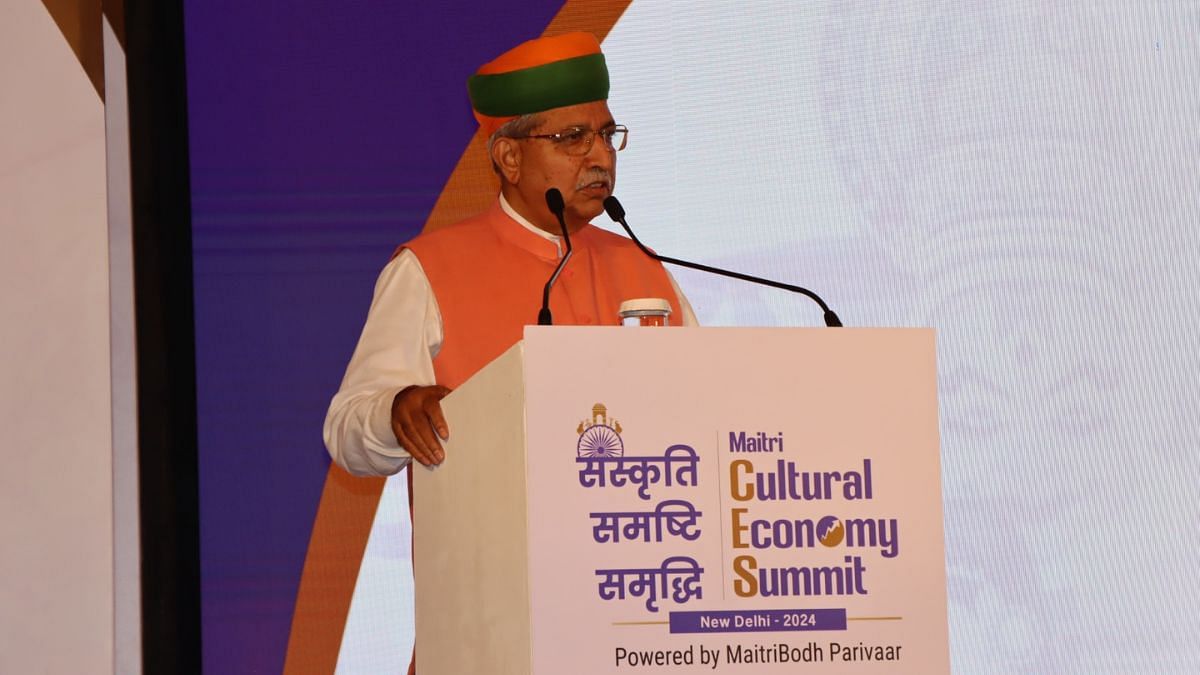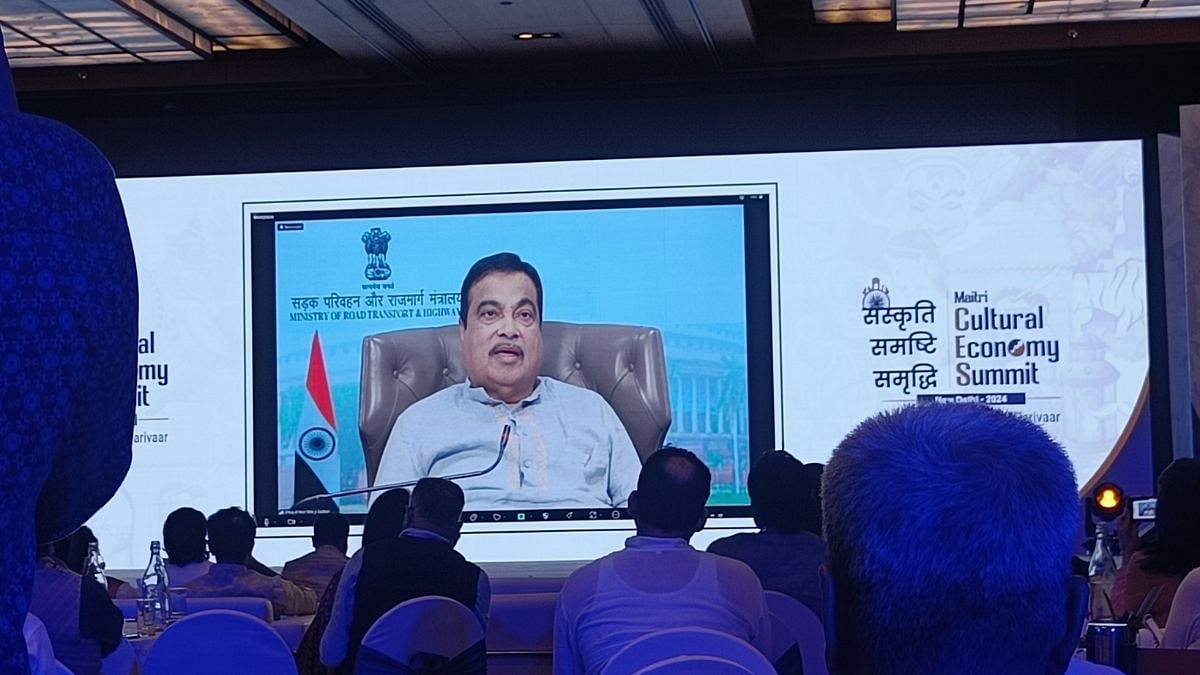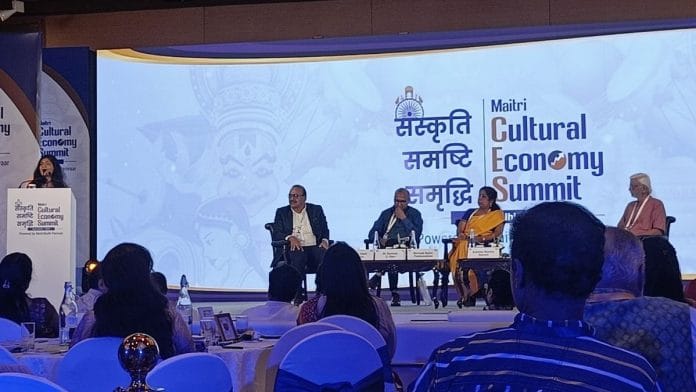New Delhi: Traditional ways to measure a country’s economic growth now stand challenged. From job creation, environment to Bhutan’s Gross National Happiness Index—now a new proposal suggests using culture to springboard economic activity the Indian way.
At the day-long Maitri Cultural Economy Summit on 6 July, Indian culture was touted as a way of life, a safeguard against recession, and the origin of human behaviour. The speakers included ministers, policymakers and economists, who were all convinced that to become the next Vishwaguru, India must embrace its Indianness.
The event organised by a “socio-spiritual” group, called MaitriBodh Parivaar, was about exploring the linkages between the country’s Sanskriti and its economy.
“Our culture has the power to boost our economy. India is the land of festivals and melas, which keeps the economy running. The 16 ‘sanskaars’ in Hindu tradition also have the potential to sustain the economy, which is why it is unaffected by the recession,” said Union Law Minister and former culture minister, Arjun Ram Meghwal, who hailed the Narendra Modi-led government’s initiatives.

Nitin Gadkari, Minister of Road Transport and Highways, Shamika Ravi, member of the Economic Advisory Council to the PM, and Canara Bank director Nalini Padmanabhan among others participated in the summit.
Gadkari echoed Meghwal’s sentiment and listed out the government’s latest religious corridor projects — Kedarnath, Mansarovar, Ram Van Gaman Marg, Ram Janki Marg, etc. “While building a culturally prosperous nation, it is important to eliminate poverty, hunger and unemployment. We will need to build ‘smart’ villages, not just ‘smart’ cities. But prosperity must be powered by culture,” he said.

Ayodhya is all about harnessing the cultural economy. It’s expected to play a vital role in Uttar Pradesh Chief Minister Yogi Adityanath’s goal to make the state a trillion-dollar economy. With an estimated annual footfall of over five crore visitors, the Ram temple city is India’s answer to Vatican City and Mecca.
“A $10 billion makeover (new airport, revamped railway station, township, improved road connectivity etc) will likely drive a multiplier effect with new hotels and other economic activities. It can also set a template for infra-driven growth for tourism,” a Jeffries Asia Equity report highlighted on 21 January.
Bhupesh Baghel’s government in Chhattisgarh spent Rs 165 crore to build a temple tourist corridor in the state. The religious trail will have 75 destinations, 60 ft tall statues of Ram and cafes serving local food. The Congress government had claimed that the tourist footfall increased ten-fold because of the development project.
Also read: Bhupesh Baghel’s Kaushalya Mandir is Chattisgarh’s own Ram trail. BJP is ‘uncomfortable’
Templenomics
Much was discussed at the summit about India’s temples, particularly those in South Indian states, and the vast economic ecosystems that surround them.
The Hindu temple properties in Tamil Nadu, Andhra Pradesh, Karnataka and Telangana are worth Rs 32 lakh crore, according to strategic business consultant and member of Hindu Dharma Acharya Sabha, K. Nagarajan.
“One can only imagine the extent of the economic progress that can be attained by the Hindu community by tapping their value,” he said.
However, he pointed out that most of these properties are controlled by the government. “For culture-led economic development to occur, the mandirs must be taken care of and for that, they should be handed back to the communities,” he said.
Temples can drive the culture-led economy in rural areas, according to panellist Shrish Kalyani.
“Government must provide initial support to temples in villages so that they become the epicentres of economic development,” said Kalyani, an associate director at Transforming Rural India Foundation.
A single edition of the Kumbh mela, the mega Hindu festival and congregation, is estimated to offer returns 12 to 15 times the local government’s investment, author Rashmi Samant noted. “Festivals, like Ganesh Chaturthi, Durga Puja and Diwali, provide the right kind of fiscal stimulus to the economy,” Samant said.
She added that the discourse around pollution and adverse impact only “targets Indian festivals”, while “no one talks about the trees cut down during Christmas season”.
“It is hypocritical how these articles are focused on enabling the global market forces to make the Indian population subscribe to spending on foreign festivals and to unsubscribe from the festivals of their own origin,” Samant said.
Also read: Modi govt push for temple corridors isn’t just about culture. It’s the economy
Yoga and scientific inquiry
The experts also turned the audience’s attention toward Indian handicrafts and the need to support the country’s artisans. Senior professor at Delhi School of Economics, Surender Kumar, suggested that tools like Geographical Indication (GI) tags and devising the right market strategies could help. University and college courses can also be designed to aid skill development among the artisans, he said.
Health and wellness — Yoga and Ayurveda— also made it to the list of the summit’s themes. “We have inherited wellness practices like Ayurveda as traditions, but we wait for the Western countries to measure, imbibe and patent their effectiveness and efficacy to begin to value them. This is because we have, somewhere down the centuries, forgotten the scientific inquiry and documentation,” Shamika Ravi said.
She emphasised the need for test and experiment in the cultural sector. “Our academia, public institutions and think tanks are doing a bad job,” she said.
The Modi government has plans to steer the culture bus toward the country’s development goals.
“India’s cultural potential should be integrated with the various sectors of economic development. At present, culture is only connected to the services sector. We want it to be connected to agriculture and manufacturing as well. Once we add the additional input of culture to an economic activity, there will be a multiplier effect,” Gopal Krishna Agarwal, BJP spokesperson and patron of the summit, told ThePrint.
He added, “It is also important for India to align itself with the global economy and consolidate its position in order to become a world leader.”
(Edited by Ratan Priya)







Commercialising religion and culture is not a way to drive economy! It is unfair to both culture and economy!!